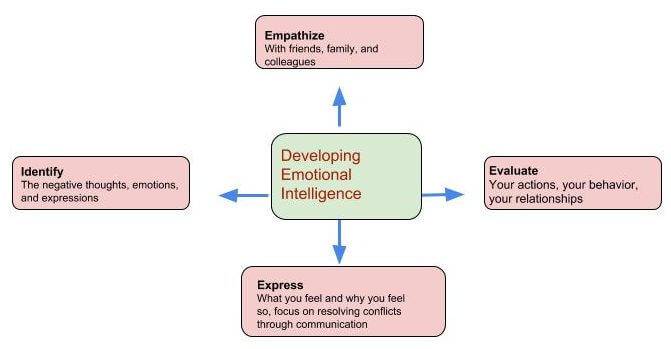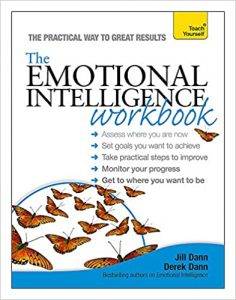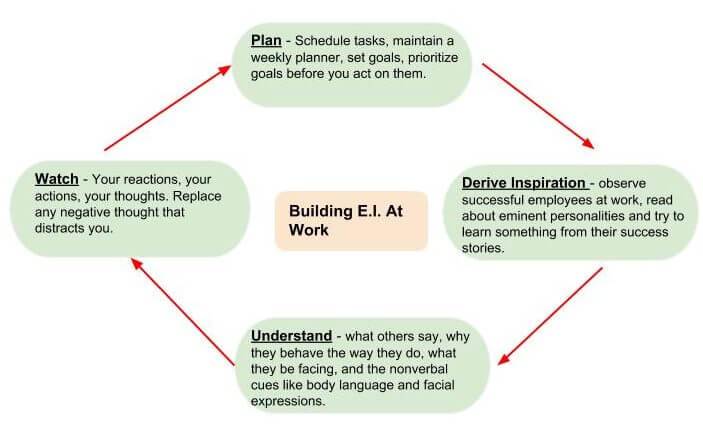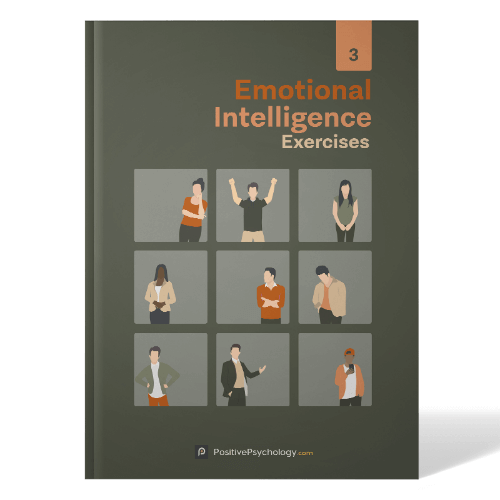How To Improve Emotional Intelligence Through Training
 Have you ever noticed your feelings?
Have you ever noticed your feelings?
How often have you stepped into others’ shoes and experienced their emotions?
How well do you understand what you feel and why you feel so?
Emotional Intelligence is our mind’s ability to perceive, manage, and express emotions effectively in real life. Jack Mayer and Peter Salovey (1990) defined Emotional Intelligence (or E.I.) as the ability to regulate feelings and use them to guide our actions.
Like I.Q., emotional intelligence varies from one person to another. While some people are gifted by birth in the way they understand and deal with people, others may need help to build their emotional skills.
Getting fluent in the language of emotions helps us sustain our relationships both personally and professionally. Emotional intelligence can empower the mind and make us happy and content.
The term “Emotional Intelligence” was first published in a paper by Michael Beldoch in 1964, but became popular after Daniel Goleman’s 1995 book “Emotional Intelligence – Why it can matter more than IQ.”
A well-balanced, empathetic, and friendly person is more emotionally aware than an unempathetic and demotivated individual. The studies of Daniel Goleman illustrated an emotionally intelligent person to have:
- The ability to recognize own emotions
- The ability to relate to others’ emotions
- The ability to actively listen to others
- The ability to actively participate in interpersonal communication and understand the nonverbal cues of behavior
- The ability to control one’s thoughts and feelings
- The ability to effectively manage emotions and express them in a socially acceptable way
- The ability to receive criticisms positively and benefit from them
- The power to forgive, forget, and move on rationally
How many of the above qualities can you relate to yourself?
In this article, we will try to uncover the practical implications of emotional intelligence and discuss how to use it for wholesome and healthy living.
Before you read on, we thought you might like to download our 3 Emotional Intelligence Exercises for free. These science-based exercises will not only enhance your ability to understand and work with your emotions but will also give you the tools to foster the emotional intelligence of your clients, students or employees.
This Article Contains:
- Can E.I. Be Learned?
- Can Emotional Intelligence Be Taught and Developed?
- How Do We Develop Emotional Intelligence?
- 5 Ways To Develop Emotional Intelligence
- What Is Emotional Intelligence Training?
- Workplace Implications of Emotional Intelligence Training
- Online Workshops and Coaching Programs for EQ
- 3 Exercises for Emotional Intelligence
- 5 Activities to Develop Emotional Intelligence (inc. Group Activities)
- Emotional Intelligence Courses and Certification
- Emotional Intelligence Workbooks
- The Role of Reflection and Practice
- Training Strategies to Improve Emotional Intelligence
- Mindfulness Practice in EQ Training
- TED Talks and Videos on E.I. Training
- A Take-Home Message
- References
Can E.I. Be Learned?
“Our emotions have a mind of their own, one which can hold views quite independently of our rational mind.”
Daniel Goleman (1995, p. 20)
Research suggests that people with average or below average E.Q. can do just as well as others by learning it. The only thing needed is the motivation to learn and the intention to apply it in real life.
Emotional Intelligence can be gained and improved at any point in life (Goleman, 2014). Learning emotional intelligence skills needs a resourceful environment where we can picture the areas, or the aspects of E.I. that we should focus on, and seek expert advice on how to do so.
4 Stages of Learning Emotional Intelligence
1. Insight
Any learning starts when we are aware that there is something in us that needs to be changed or improved, and we are ready to make those changes happen. Emotional intelligence has five components in it:
Self-awareness – the knowledge of what we feel and why we feel so
Self-regulation – the ability to express our feelings in the right way
Motivation – the internal drive to change the way we feel and express
Empathy – the ability to relate to others’ emotions and see the world from their perspective
Social skills – the power to communicate effectively and build strong connections at home or in the workplace.
Learning E.I. starts with gaining insight into which aspect of E.I. we should work on. Some of us may have solid social skills but lack in self-regulation while others may be high on motivation but poor in self-regulation. The learning process begins with the knowledge of which aspect of E.I. to develop first.
2. Assessment
The next step is attempting to measure where we stand on each of the E.I aspects. E.I. tests are widely available online, or if you are seeking training in a professional setup, there will be materials provided to you for assessing your emotional intelligence.
Here are a few assessments and emotional intelligence tests that we can take for evaluating our E.I. The scores in each of them are indicative of whether or not we need to learn emotional skills, and where do we practically stand as an emotionally aware human being.
More on E.I. assessments and resources in the upcoming sections.
3. Training
Assessment opens us to a range of options to choose from. Depending on what part of emotional intelligence we need to work on, we can decide what sort of training would suit us the best. For example, a low score in motivational and social communication aspects can be improved by organizational training.
Many professional sectors offer E.I. courses and workshops for employees who are keen to build their interpersonal skills.
E.I. training improves:
- Communication skills and the power to comprehend nonverbal cues of interaction (for example body language, facial expression, the tone of words, etc.)
- Group performance, especially at the workplace and maintaining a high team spirit
- Organizational skills – and managing schedules more efficiently
- Work motivation and the power to accept feedback and criticism positively
- Leadership skills
4. Application
The final and the most critical stage of learning emotional intelligence is incorporating the chalk talk in real life. The exercise and self-help activities that structure E.I. courses are productive only when we can implement in real-life situations.
The skills and techniques that these learning modules impart to us can be used in:
- Interacting with people at personal and professional levels
- Understanding and labeling our own emotions
- Expressing what we feel in a way that will not upset others
- Understanding others’ feelings and listen to them without judgment
Can Emotional Intelligence Be Taught and Developed?
Teaching emotional intelligence to individuals not only builds their emotional skills, but it also sustains the education over several years (Nelis, Quoidbach, Mikolajczak, & Hansenne, 2009).
Delphine Nelis, a cognitive psychologist, established her fact in an experiment with 40 college students. She divided the sample population into two groups and provided a four-week E.I. training to only one of the groups.
Findings from her study indicated that the group that received the practice not only showed marked improvement in their emotional abilities, but they also continued to manifest the same even after six months of the experiment.
Although this was a small scale pilot study to understand the influence of emotional intelligence training, the results were quite significant and suggested the possible long-term effects of education on E.I.
Although Delphine Nelis initiated this pilot study, now you can also become an Emotional Intelligence Expert and teach others by enrolling in our highly acclaimed Emotional Intelligence Masterclass©. This is the best way to help others understand and use their emotions in life-enriching ways.
How Do We Develop Emotional Intelligence?
“If you are tuned out of your own emotions, you will be poor at reading them in other people.”
Daniel Goleman
Emotional Intelligence includes skills like self-motivation, emotional regulation, self-management, empathy and impulse control (Goleman, 1995). It has been an enthralling area for mental health professionals for over 25 years now.
The reason why IQ is independent of EQ is that EQ continues to improve and enhance over a lifetime, so it is never too late to start learning about Emotional Intelligence.
E.Q. and I.Q.
| Emotional Quotient | Intelligence Quotient | |
|---|---|---|
| Characteristics | Empathy, good interpersonal relationships, survival skills, ability to control impulses, thoughtful, sensitive | Logical, analytical mind, reasoning abilities, abstract thinking, problem-solving abilities |
| Suitable professions | High E.Q. are suitable for teams and managerial responsibilities, individual business, social works, working with non-profit organizations for humanitarian causes, counseling, human resource jobs | People with high I.Q are great at Mathematical jobs, software and web development, linguistics, programming jobs |
| Assessments | 1. Mayer-Salovey-Caruso Test 2. Daniel Goleman Model Test 3. Emotional Quotient Inventory |
1. Stanford-Binet Intelligence Scale 2. Wechsler Intelligence Scale For Adults and Children |
5 Ways To Develop Emotional Intelligence
Developing emotional intelligence implies developing a cluster of innate qualities that help us in enhancing our mental wellbeing on a day-to-day basis. Here are five simple ways that we can follow besides professional E.I. training to develop our affective awareness optimally.
1. Identifying The Negative Emotions
A large chunk of emotional intelligence lies in emotional management. How well we manipulate our feelings and efficiently use them makes us more resilient and immune to stress. When we can label the emotions that bring us down, we are less likely to get overwhelmed by external adversities and exhaust our mental energy.
Wondering where to start? Here are some easy tricks that will make the task easier:
- When someone upsets you or uses harsh words, don’t react immediately. Withdraw yourself from the heated situation and take some time to gather your thoughts and ‘choose’ your responses wisely.
- Do not jump to conclusions. Check yourself the moment negative thoughts start clouding up.
- In a time of distress, especially interpersonal conflicts, spare some moments to look into the matter from the other person’s perspective. Try to get in his/her shoes and understand what made the person behave that way. Notice how your attitude changes the moment you start empathizing.
2. Self-Evaluation
Before observing and understanding others, watch yourself. To develop E.I., we must learn to assess ourselves objectively and look into our actions from a bird’s eye view. Challenge your thoughts by regularly asking yourself questions like:
- Am I thinking the right way?
- Should I have used those words today?
- How would I have reacted if I were in his/her place?
- Is there another way of looking into the matter?
- Am I on the right track?
- Is my family happy with me?
Frequent encounters with the self enhance perception, creates humility, together which contribute to building E.I.
3. Self-Expression
Self-expression and emotional intelligence go hand in hand. Without one, we cannot build the other.
People who can identify and express their thoughts effectively and in a more socially acceptable way usually are high on emotional intelligence and self-efficacy (Mayer & Geher, 1996).
Self-expression means focusing on stronger and better communication with others, conveying our thoughts naturally and understandably, and attending to a solution with communication. If we can choose the right way to tell others how we feel and why we feel that way, we are already more solution-focused and self-regulated.
4. Stress Management
Recent studies have indicated that people with emotional clarity and awareness are better at handling stress than others. Especially in the workplace, stress and burnout causes a marked degradation in our overall emotional capabilities and influence the way we respond to them.
People who achieve tremendous success in their professional lives do not get it only because they are good at the job, a lot of the success is the byproduct of their emotional and self-awareness (Schuler, Dowling, & De Cieri, 1993).
Prolonged exposure to stress without efficient coping strategies can open us to a plethora of mental health problems.
The most helpful stress reduction method is by consciously using our senses and staying close to nature (Leelavati & Chalam, 2020).
Simple stress management techniques like the following can also make a significant difference in dealing with hardships without getting drained:
- Splash cold water on your face after a stressful encounter and get back to work after that. Cool conditions usually help in reducing the anxiety levels and give a feeling of freshness.
- Avoid caffeine and smoke during hard times. Though people resort to these substances more during stress, it is best to avoid such stimulants when you feel nervous.
- Take a break from work when the job stress takes a toll on your mental and emotional wellbeing. Go out with your family and spend some quality time to regain insight and come back to combat stress more effectively.
5. Empathy As A Daily Habit
Empathy is the power to see the world with others’ eyes.
It is an essential aspect of any mental health-related area of research (Larson & Yao, 2005). Relating to others’ thoughts and understanding what might have influenced them to behave in that way is a significant milestone in emotional development (Reynolds & Herman, 1994).
Empathy begins at home. Random acts of kindness like a thank you note, a little help to offer, or an open heart-to-heart conversation is all that takes to set foot towards an empathetic life.
Even at the workplace, listening to a colleague without judging, or accepting harsh words from someone undergoing stress, can significantly build our emotional and social intelligence, thereby strengthening interpersonal bonds.

What Is Emotional Intelligence Training?
“It is very important to understand that emotional intelligence is not the opposite of intelligence, it is not the triumph of heart over the head – it is the unique intersection of both.”
David Caruso
Emotional intelligence is a fruitful impetus to a successful career and leadership (read our Leadership Effectiveness article for more). Gill Hasson, in his book “Emotional Intelligence: Managing Emotions to Make a Positive Impact on Your Life and Career” (2014) has indicated how emotional intelligence has helped professionals at different levels to move up the ladder and sustain their success over time.
Emotional Intelligence Training is a set of practical knowledge and skills that help individuals to become fluent in understanding the language of emotions.
The training aims at developing:
- Self-motivation
- Productivity
- Commitment to profession
- Confidence and flexibility
- Empathy
- Communication skills
- Long lasting and strong interpersonal relationships – personal and professional
- Self-awareness and self-control
Professional emotional intelligence training programs help in improving our existing emotional skills by:
- Modeling the right emotional skills to the participants
- Assisting the participants to understand and apply the techniques in their real lives
- Helping leaders and professionals reflect their emotional intelligence on their team
- Helping participants identify the belief system that might be interfering with their effectiveness
- Exposing the participants to other ways of thinking and reacting to a situation
- Challenging the participants to create and implement new strategies of understanding and dealing with others at a professional level
- Encouraging leaders to provide feedback and positive reinforcement to his/her team and comprehend the happiness of the teammates
- Measuring the results of the training provided through self-assessment or other ‘in-vivo’ approaches
- Appreciating and acknowledging the efforts given by the participants to build their emotional intelligence at work.
Workplace Implications of Emotional Intelligence Training
“CEOs are hired for their intellect and business expertise – and fired for a lack of emotional intelligence.”
Daniel Goleman (1995, p. 16)
Recent studies have suggested that most organizations that hire managers today base their selection on how aware the person is, emotionally. Intellectual assessments come after that (CareerBuilder, 2011).
Whether it is dealing with clients and financers, serving the customer care area, teaching, or helping the people in general, unless we can establish a connection with the people across the table, we cannot yield the maximum results. Emotional Intelligence Training at the workplace is gaining immense popularity now.
Through valuable resources, manuals, and practical assessments, professional E.I. training aims at:
- Helping participants communicate effectively with their colleagues, superiors, and subordinates
- Motivating them to perform as a group and build a great team spirit within the organization
- Making new business connections and maximizing financial goals
- Helping them evaluate their progress and providing the scope to improve their existing skills
- Building a high-performance work culture where employees are high on self-motivation and can manage their emotions efficiently
- Promoting good leadership and managerial skills by being emotionally aware and mindful at work.
Online Workshops and Coaching Programs for EQ
1. Emotional Intelligence Masterclass©
The Emotional Intelligence Masterclass© is a complete, 6-module emotional intelligence training template for helping professionals.
Compiled and offered by psychologist and researcher Dr. Hugo Alberts (Ph.D.) who has been exploring the scientific side of positive psychology for the past 10 years, you can master the 6 pillars of emotional intelligence.
If helping others to improve their lives is your passion in life, this masterclass will provide you with all the tools, materials and knowledge to make an impactful difference.
The masterclass includes the following modules:
Module 1 – Emotions
In this module, you will learn what emotions are. Why and how do they seem to involve many different physical and mental processes at the same time?
Module 2 – Emotional Intelligence
Over the past 20 years, emotional intelligence (EI) has become a popular construct in the field of psychology and beyond. But what is EI exactly?
Module 3 – Emotional Awareness
Emotional awareness is a fundamental skill to emotional intelligence. In short, it is the ability to answer the question: How am I feeling right now?
Module 4 – Beliefs About Emotions
In this module, we will discuss the beliefs about emotions that operate outside conscious awareness, and strongly determine the relationship people have with their emotions.
Module 5 – Emotional Knowledge
When emotions and rationality are combined, they start to function as data; they reveal information about two important motivators of behavior: needs and values.
Module 6 – Emotional Expression
Emotional expression refers to the ability to name and express what is happening emotionally. Emotionally intelligent people are skilled at expressing their emotions.
2. The Emotional Intelligence Institute
The E.I. Institute in Western Australia provides valuable online emotional intelligence coaching and masterclasses for business owners, managers, supervisors, team leaders, and employees at other levels.
Their online programs focus on:
- Emotional Intelligence and practical methods to regulate emotions
- Change management at the workplace
- Learning and developing leadership skills
- Positive psychology at work
- Presentation skills for public speaking and feedback management
The online coaching programs offered by the E.I. Institute are conducted at three levels:
1. The Foundation Level
Anyone, from anywhere, can participate in the Foundation Level Tele-Classes to get introduced to the basics of E.I. and the practical implications of it in professional and personal lives.
2. The Specialist Level
The workshops organized at the specialist level is designed to profit specific professions like human resource, real estate, government officials, and telecommunications.
3. The Leadership Level
The leadership workshops and training are highly equipped and designed to benefit people working as CEOs, CFOs, trustees, and other senior leadership designations in leading industries.
3. Foundation Skills On Emotional Intelligence
The Foundational Skills On Emotional Intelligence is a 24-week online course targeted at individual emotional skills improvement. The course offers a flexible schedule and benefits individuals of more or less all ages and occupations.
4. Emotional Intelligence Coaching Certification
Conducted by the Key Step Media, the Emotional Intelligence Online Coaching is an in-depth program that aims to improve the five aspects of E.I. as Goleman had pointed – self-awareness, emotional regulation, self-expression, adaptability, and focus. This course is suitable for individuals who want to extend their services as a passionate E.I. coach.
5. E.I. Coaching By Wendy Jocum
Wendy Jocum is an accredited emotional intelligence coach and test administrator. In her workshops on emotional intelligence, she trains participants to identify their emotions, challenge the negative emotions, and change them for professional and personal wellbeing.
The workshops she conducts are well-designed and involves psychometric assessments conducted individually as well as in groups.
4 Exercises for Emotional Intelligence
1. Self-Awareness Exercise
Start building self-awareness by recollecting the emotions you felt throughout the day. List your feelings and try to name them, this will help you know yourself better. Once all the emotions are there as words, start analyzing them.
How many positive and negative emotions can you see? Which are the ones that have affected you the most today? What caused these emotions? You need not act on them or judge what is right and wrong here. Just focus on observing each feeling and write them down honestly.
| Day | Positive Emotions – happy, proud, satisfied, cheerful, enthusiastic, etc. | Why did I feel so? | Negative Emotions – sad, upset, angry, depressed, lonely, insecure, etc. | Why did I feel so? |
|---|---|---|---|---|
| Mon | ||||
| Tue | ||||
| Wed | ||||
| Thu | ||||
| Fri | ||||
| Sat | ||||
| Sun |
2. The Trust Thermometer
The trust thermometer is an exciting group activity that fosters interpersonal trust. The exercise involves participants to line up against a wall and step forward as they respond. Several real-life situations are given to the respondents, and they are asked to make moves according to the level of trust they think they have in each case.
Conditions may include:
- A friend borrowing money
- A friend blindfolding you and taking to unknown place
- Having lunch with unknown people
No move, or standing against the wall would mean the person has no trust in the situation and the individual/s involved in it. Taking 4 or 5 large steps forward would likewise imply that the person has complete trust in the circumstance given to him.
3. The Self-Expression Exercise
This exercise was initially conducted in a classroom situation with students but can be effectively incorporated in other forms too. The task involves the following steps:
- List good and bad emotions on the board.
- Call the participants one by one and ask them ‘How are you feeling?’.
- If the participants give flat answers like ‘fine’, go ahead asking them what makes them feel ‘fine’.
- Ask them to name how they are feeling right now and highlight those emotions on the board.
- At the end of the session, allow some time for the participants to discuss feelings with each other.
Discussing things like why we say we are fine even at times when we don’t feel so good or what makes us ask another person about his/her feelings lets the participants gain clarity on the power of emotions and self-expression.
4. Leadership Toolkit For Emotional Intelligence
The Leadership Toolkit is a specialized handbook designed for professionals working in leading positions. There are 50 questions in the assessment that are answered on a 5-point scale, and the scores evaluate E.I. on the five dimensions – self-awareness, emotional regulation, self-motivation, empathy, and social skills.
Find more exercises here: 13 Emotional Intelligence Exercises & Activities
5 Activities to Develop Emotional Intelligence (inc. Group Activities)
Self-Awareness For Leaders
As a leader, actions matter more than words. This exercise is for leaders and supervisors who manage large teams in the workplace.
It is best when practiced in a group, for example, in stand up meetings or orientation programs is an excellent indicator for evaluating the group thinking.
| Self-Awareness Group Exercise For Leaders |
|---|
| Ask your employees/teammates the following questions and urge them to record their responses on paper:
What do you think is missing from our team? How do you think I view your contribution to the team? Do you think you are important in this group? As a leader/manager/supervisor what do you think I have done to benefit the team? How have I made you feel part of the group? |
Once all the participants have recorded their answers, encourage them to share their opinions and listen to each other actively. Make the session as interactive as you can. Practice this exercise once a month or a fortnight to enhance self-awareness as the leader of the group.
The Mastery Of Vision
One of the most critical components of emotional intelligence is self-motivation and competence. The mastery of vision exercise is a rehearsal process that strengthens the power of visualizing success and rebuilds focus to act on the goals systematically.
This exercise can be conducted individually or as a group and involves the following questions. The questions are subjective, self-evaluative, and there are no right or wrong answers here.
| The Mastery Of Vision Exercise |
|---|
| Imagine yourself in your dream job, in the designation you always wanted to be.
See yourself as an expert of the job and ask yourself the following questions: a) I will contribute to the organizational success in the following ways b) I will use the following strategies to keep my team happy c) I will reward my employees/teammates in the following ways d) Working in my dream role, I would like to build myself in the following ways e) If I get to serve the role, these are the goals that I wish to accomplish in a year/month/week Go through your responses and try to analyze if you can plan your actions according to it. Keep the test as a reference and conduct it once or twice a year to align your thoughts with your goals. |
Self-Expression Group Activity
Mastering over our emotions and the way we choose to express them constitutes a large portion of emotional and social intelligence. This exercise is a mood map that lets the participant evaluate his/her emotions and explore the causal factors of it.
The training is conducted in pairs where one person asks a set of questions to his/her partner and allows the partner to explain himself/herself. It is a great way to gain clarity of self-expression in a social set-up.
| Self-expression Group Activity |
|---|
| Participate in pairs and take turns to answer each question asked to you. When you are responding, make sure you convey what you feel and establish eye-contact with the listener.
a) When was the last time you felt happy at work? Why did you feel happy? How did you express your happiness? b) When was the last time you failed at work? How did it affect you? c) Do you get angry at work? What do you do when you are mad? d) Think about a time when your team performed well. How did you feel? Did you feel responsible for your team’s success? e) What disappoints you the most at work? How do you deal with the disappointments outside of work? |
Self-Management Exercises For Building E.I.
1. Breath control
A 2-minute breathing exercise every day can reduce stress and burnout caused due to work. (Salyers et al., 2011). By consciously focusing on our breaths, taking deep breaths especially during stressful situations can instantly calm the mind and help us think right.
2. Stress management
Here are some simple hacks for immediate stress reduction:
- Journal your thoughts every day. Write down everything that you cannot express or share with others. Let the negative emotions get a vent.
- Count to 10 before reacting or responding to conflict.
- Stay away from arguments as much as you can.
- Avoid confrontation if you cannot manage your emotions. Use phone or email to communicate.
- Share your problems with someone close to gain a broader perspective on the matter.
3. Cognitive Reconstruction
To gain a better understanding of any situation, try to alter your thinking. Whenever you feel angry, sad, or disappointed, ask yourself:
- Can there be a different way of looking into the matter?
- Is there a lesson that I learned from this experience?
- Could there be any other way of reacting to the situation?
- If this happens again, will I react in the same way?
- How would I have felt if I was in his/her position?
4. Problem-solving Checklist
Perhaps one of the most realistic and practical self-assessments for managing and regulating emotional awareness. Make a weekly chart with all the issues that you need to resolve within the week – including your personal and professional setbacks.
Set aside 5-10 minutes every day where you come back to the problem list and write down the ways that you can resolve each of them. As you successfully solve one problem, strike it off the checklist and proceed from there. A sample checklist can look something like this.
| Problems | How they are impacting my life | Strategies to solve them | Resolved (√) | Unresolved (✕) |
|---|---|---|---|---|
| ——– | ——– | ——– | ——– | ——– |
Relationship Management
Emotional intelligence enhances with the power of building and sustaining long-term relationships at home and work (Gardner & Stough, 2002).
Managing relationships is not an objective, step-by-step method. We need to feel the emotions and find the perfect balance between holding and letting go. Here are some simple practices to help you build your relationships at personal and professional standards:
- Show your feelings – communicate and express your emotions in the right way. Whether it is love, anger, or disappointment, express through clear communication. Bottling up feelings, besides ruining the relationship, also results in them coming out in worse ways later.
- The little things matter – do not hesitate to say ‘thank you’, ‘sorry’, or ‘please’. It might mean a lot to someone and help in growing the bond you share with that person.
- Explain – When facing a conflict with someone close, remember to explain your actions and decisions. Communicate to resolve the conflict, not to aggravate it.
- Handle tough conversations – Look into things from others’ perspective and put yourself in their shoes. In stressful situations, let others express their opinions. Listen actively, do not judge or jump to conclusions. Accept if you are wrong and agree to disagree. Make sure you end the conversation on a positive note.
Emotional Intelligence Courses and Certification
The SkillSoft Emotional Intelligence Training
Skillsoft, an online business training platform conducts a series of Emotional Intelligence Training courses which are targeted to benefit business professionals and management personnel. The training focuses on building self-management and emotional regulation by tuning in to our feelings.
The specific courses that they offer include:
- Understanding Emotional Intelligence in leadership
- Emotional Intelligence Quotient (E.Q.) building course
- Emotional Intelligence in the workplace
- Self-management through emotional intelligence
- Practical applications of emotional intelligence at work
- Emotional management and E.I.
The High Performing Systems (HPS)
HPS is a US-based organization well-known for its online certifications and training resources on emotional intelligence. The HPS has a separate branch dedicated to emotional intelligence courses. Pieces of training are conducted under the supervision of Dr. Henry L. Thompson, Ph.D. and founder of the HPS.
The E.I. training provided includes:
- The EQ-i 2.0 Certification – A standard self-report measure for evaluating emotional intelligence.
- The MSCEIT Certification – An online certification that provides online training on the administration of the Mayer Salovey Caruso Emotional Intelligence Test, that evaluated our capacity for emotional reasoning. This certification is ideal for professionals who aim to make a better impression to supervisors and clients.
- The TESI Certification – The Team Emotional and Social Intelligence Survey Certification is a group training where each member is required to rate the team on seven TESI dimensions. The training helps in building emotional identity, awareness, communication, and stress resilience at work.
Emotional Intelligence 2-Days Course
An Australia-based leadership-oriented training, this course focuses on:
- Defining E.I.
- Explaining the role of E.I. at work
- Exploring the causes of failure
- Building intrapersonal and interpersonal skills
- Strategies for building E.I. skills
- The power of motivating others positively
- Business networking and client management
The assessments include EIQ16 Questionnaire which measures our ability to accurately perceive, use, and facilitate emotions to understand and manage actions.
Emotional Intelligence Workbooks
1. The Emotional Intelligence Workbook – Jill and Derek Dann

The workbook comes as a compilation of cutting-edge explanations coupled with scientific assessments and a practical style of learning.
Find the book on Amazon.
2. The Emotional Intelligence Workbook by Paul Gerhardt

Find the book on Amazon.
3. Mini Emotional Intelligence Test and Workbook
A more or less all-in-one collection for emotional intelligence tests and activities, the Mini EI Workbook was developed by the Ghyst & Associates and Brent Darnell International, a one-stop destination for online courses and training resources.
The workbook takes us through the different aspects of E.I and personality and helps us deeply internalize the ‘what’, ‘why’ and ‘how’ of our emotions.
For more books on EI, see: 26 Best Emotional Intelligence Books
The Role of Reflection and Practice
Self-reflection is vital for any education or training as it provides support, promotes discipline, and retains the knowledge that is learned (Green, 2001). Reflective practice in building emotional intelligence refers to the ability to pay continuous attention to the practical application of theoretical evidence and knowledge.
Research has shown that repeating the skills that we acquire in any learning situation gives us the opportunity to challenge our limits and face real-life challenges better (Farrell, 2007; Lee, 2005).
Reflection is values put into action. Self-reflection is vital for building emotional intelligence because:
- It helps us know ourselves better
- It lets us resonate our thoughts on others and vice versa
- It empowers us to support others to build their emotional awareness
- It drives us closer to solutions and to become more proactive in choosing the right actions.
Training Strategies to Improve Emotional Intelligence
E.I. training strategies are successfully implemented across sectors like education, mental health and disability, project management, and leadership (Zijlmans, Embregts, Gerits, Bosman, & Derksen, 2011). Karima Mariama-Arthur, in one of her articles on emotional intelligence training that was published in 2015, mentioned about five strategies that aid emotional intelligence training.
Although her article was primarily leadership-oriented, the plan can be useful for all E.I. training methods.
The programs are based on Goleman’s (2004) five domains of E.Q. that include:
- Emotional Awareness – paying more attention to our inner thoughts and feelings, naming the good and bad emotions, and consciously accepting to change them.
- Self-Motivation – looking beyond the immediate difficulties and pushing the self to actively execute plans and accomplish goals.
- Empathy – immersing ourselves entirely into the mind of others, thinking what they think, feeling what they feel, and understanding the world from a different perspective. Undoubtedly, one of the most robust and highest forms of evolving as an emotionally intelligent being.
- Relationship Management – involving active listening, effective communication, decision-making, conflict management, and coping strategies.
- Effective Communication – incorporating training methods for understanding nonverbal cues of communication like body language and facial expressions, better ways of expressing one’s feelings and the appropriate means of communicating in different situations.
Mindfulness Practice in EQ Training
“Every morning we are born again. What we do today, is what matters the most.”
Emotional Intelligence lies in gaining awareness, in becoming consciously present in the ‘now’ and taking the full charge of our actions. Mindfulness creates the framework of emotional enlightenment. Mindfulness practices help us enact on the behavioral changes that we need for building our E.I.
Mindfulness in emotional training includes:
1. Accepting and adapting to change
Easy mindful practices like thought counting, word watching, or myth busting can help in gaining awareness into our problems and accepting that we need to change ourselves to be happier in life.
2. Building a growth mindset
A growth mindset is where we feel safe to try new things and do not fear failure. A growth mindset is fostered through mindfulness programs at the workplace.
| Building Growth Mindset Through Mindfulness | |
|---|---|
| Instead Of Telling Yourself… | Try Reminding Yourself… |
| 1. I can’t do this | 1. I can at least give it a try |
| 2. I quit | 2. I should give myself another chance |
| 3. I can’t help it | 3. I should talk to the team leader about this |
| 4. I don’t deserve this | 4. Did I try my best? |
| 5. Everyone can do this except me | 5. I can go and learn from them |
| 6. I might make a mistake, so I won’t attempt giving it a try | 6. If I make a mistake, I will try to use the lesson and not repeat it again |
3. Gauging the outcome of actions
Mindfulness promotes self-evaluation and self-awareness. Individuals who attend individual or group mindfulness sessions are more keen to know their mistakes and ready to rectify them. They gain emotional awareness through curiosity and the desire to change.
4. Noticing our own reactions by staying more aware in the present
Mindfulness practices act as a mirror. They let us see our actions and identify the emotional triggers – what caused the adrenaline rush? Why did we behave the way we did? How do we feel about it?
By letting in these introspections, mindfulness takes us through self -management and emotional regulation – the two most important pillars of emotional intelligence.
TED Talks and Videos on E.I. Training
6 Steps To Improve Your E.I.
What Is Emotional Intelligence?
Introduction to E.I. by Daniel Goleman
Practicing Emotional Intelligence by Jason Bridges
Emotional Mastery by Dr. Joan Rosenberg
Workshop on Emotional Intelligence
Presentation On Emotional Intelligence – By Andrew Schwartz
A Take-Home Message
“When emotional intelligence merges with spiritual intelligence, human nature is transformed!”
Emotional Intelligence is the sum of balance, expression, and rational thinking. It gives us the chance to advance as a human and prosper as a leader. Building E.I. is continuous and progressive – we need to put efforts consistently and seek for reaching our goals.
Remember, the secret to being emotionally aware lies in finding the weakness, turning them into strengths, and repeating the process until we master it.
For further reading:
- Is Emotional Intelligence Relevant for Kids? (Games, Cartoons + Toys)
- The Emotion Wheel: What is It and How to Use it? [+PDF]
We hope you enjoyed reading this article. Don’t forget to download our 3 Emotional Intelligence Exercises for free.
- Beldoch, M. (1964). Sensitivity to expression of emotional meaning in three modes of communication. In J.R. Davitz (Ed.), The communication of emotional meaning (pp. 31-42). New York, NY: McGraw-Hill.
- CareerBuilders. (2011, August 18). Seventy-one percent of employers say they value emotional intelligence over IQ, according to CareerBuilder Survey [Press release]. Retrieved from https://www.careerbuilder.ca/share/aboutus/pressreleasesdetail.aspx
- Farrell, T. S. (2007). Reflective language teaching: From research to practice. New York, NY: Bloomsbury Publishing.
- Gardner, L., & Stough, C. (2002). Examining the relationship between leadership and emotional intelligence in senior level managers. Leadership & Organization Development Journal, 23(2), 68-78.
- Goleman, D. (1995). Emotional intelligence: Why it can matter more than IQ. New York, NY: Bantam Books.
- Goleman, D. (2004, January). What makes a leader? Harvard Business Review Magazine. Retrieved from https://hbr.org/2004/01/what-makes-a-leader
- Goleman, D. (2014). Liderazgo. El poder de la inteligencia emocional. Barcelona, Spain: B de books.
- Green, M. (2001). Successful tutoring: Good practice for managers and tutors. London, UK: Learning and Skills Development Agency.
- Hasson, G. (2014). Emotional intelligence: Managing emotions to make a positive impact on your life and career. West Sussex, UK: John Wiley & Sons.
- Larson, E. B., & Yao, X. (2005). Clinical empathy as emotional labor in the patient-physician relationship. Jama, 293(9), 1100-1106.
- Lee, H. J. (2005). Understanding and assessing preservice teachers’ reflective thinking. Teaching and Teacher Education, 21(6), 699-715.
- Leelavati, T. S., & Chalam, G. V. (2020). Can emotional intelligence be developed? International Journal of Multidisciplinary Educational Research, 9(7), 104-109.
- Mariama-Arthur, K. (2015, March 12). 5 Reasons to beef up your emotional intelligence. Success. Retrieved from https://www.success.com/5-reasons-to-beef-up-your-emotional-intelligence/
- Mayer, J. D., & Geher, G. (1996). Emotional intelligence and the identification of emotion. Intelligence, 22(2), 89-113.
- Nelis, D., Quoidbach, J., Mikolajczak, M., & Hansenne, M. (2009). Increasing emotional intelligence: (How) is it possible? Personality and Individual Differences, 47(1), 36-41.
- Reynolds, L. T., & Herman, N. J. (Eds.). (1994). Symbolic interaction: An introduction to social psychology. New York, NY: General Hall.
- Salovey, P., & Mayer, J. D. (1990). Emotional intelligence. Imagination, Cognition and Personality, 9(3), 185-211.
- Salyers, M. P., Hudson, C., Morse, G., Rollins, A. L., Monroe-DeVita, M., Wilson, C., & Freeland, L. (2011). BREATHE: A pilot study of a one-day retreat to reduce burnout among mental health professionals. Psychiatric Services, 62(2), 214-217.
- Schuler, R. S., Dowling, P. J., & De Cieri, H. (1993). An integrative framework of strategic international human resource management. Journal of Management, 19(2), 419-459.
- Zijlmans, L. J. M., Embregts, P. J. C. M., Gerits, L., Bosman, A. M. T., & Derksen, J. J. L. (2011). Training emotional intelligence related to treatment skills of staff working with clients with intellectual disabilities and challenging behaviour. Journal of Intellectual Disability Research, 55(2), 219-230.
Let us know your thoughts
Read other articles by their category
- Body & Brain (41)
- Coaching & Application (49)
- Compassion (27)
- Counseling (46)
- Emotional Intelligence (23)
- Gratitude (16)
- Grief & Bereavement (19)
- Happiness & SWB (35)
- Meaning & Values (26)
- Meditation (21)
- Mindfulness (42)
- Motivation & Goals (42)
- Optimism & Mindset (33)
- Positive CBT (24)
- Positive Communication (21)
- Positive Education (41)
- Positive Emotions (28)
- Positive Psychology (33)
- Positive Workplace (38)
- Relationships (31)
- Resilience & Coping (33)
- Self Awareness (21)
- Self Esteem (38)
- Software & Apps (23)
- Strengths & Virtues (28)
- Stress & Burnout Prevention (27)
- Theory & Books (42)
- Therapy Exercises (30)
- Types of Therapy (53)






What our readers think
Interested in enrolling in a masterclass for E.I
How is this done?
Hi Debbie-Ann,
You can learn more about our Emotional Intelligence Masterclass from our store page. The course is self-paced, so you can enroll and make a start at any time.
Hope this helps!
– Nicole | Community Manager
This concept is a good way to enhance the knowledge. thanks for sharing. please keep it up.
i would like to attend training session on EQ.
kindly share the training duration and details
Hi Lalit,
The ideal training session for you will depend on whether you are interested from an individual perspective, seeking corporate training, etc. A good starting point may be to check out these free courses listed on EQ.org. You may also find something suitable on Udemy, such as this course.
Hope this helps!
– Nicole | Community Manager
This is superb article! Thanks.
I coach students appearing for Civil Services Examinations.
Keep up the great work!
Make the world a better place!
There is a great need to improve EI, not just our technical skills. In the age of digital revolution we tend to forget to stay a bit more human.
I want to do a course in EI and want to help kids developing the skill
Why do you offer “free” exercises and when I enter my e mail, you ask for my credit card number. What a shame!
THE ARTICLES ARE JUST SUPERB.KINDLY KEEP UPDATING ME WITH MANY MORE SUCH ARTICLES.
OK ASHA, THANK YOU SO MUCH FOR SAYING THAT 😉